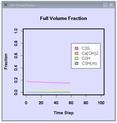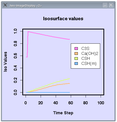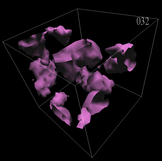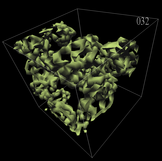When cement powder is mixed with water, complex chemical and microstructure changes occur. This is termed hydration.
Understanding the complex chemical changes that occur when cement powder is mixed with water is a long-standing but extremely challenging technological goal. Fundamental computational modeling of the hydration of cement is difficult because it involves a large number of coupled nonlinear rate equations that must be solved on a random three-dimensional spatial domain. To address these challenges, we are applying a new computational model called HydratiCA, which has several advantages over previous attempts to model cement paste hydration. HydratiCA is based on concepts of transition state theory and uses stochastic cellular automaton algorithms to simultaneously model 3-D reaction and transport phenomena. This allows us to track the detailed kinetics and equilibria that occur in a diverse range of cementitious systems. At the length scales required to finely resolve the reaction mechanisms and microstructure changes in cement paste, HydratiCA must take small time steps (approximately 10-5 seconds) to remain numerically stable. In other words, tens of millions of time steps are required to simulate the behavior of cement paste for just one hour. Therefore, parallelization of the model is important so that we can model systems that are large enough to be realistic, avoiding finite size effects, and still be able to complete the simulations in a reasonable amount of time.
Visualization is important first for validation as model development proceeds. It is also
important to facilitate understanding the distribution of phases in 3D.
The output of the hydration numerical simulation is a 3D volume of data with
percentage values for each of multiple material phases at each voxel location.
Over the course of the simulation time, a series of data volumes is produced
at the time intervals of interest. For each data set, an over all Volume
Fraction is computed for each phase and plotted as a 2D graph (See Figure 1)
using the R statistical and graphics software (www.r-project.org).
From the Volume Fraction values, a series of Isosurface Values is computed and also displayed as a 2D graph. (See Figure 2)
For each material phase (Figure 3 and 4) a series of isosurfaces is generated using VTK
(www.vtk.org). These time series of
isosurfaces are combined (Figure 5) into a 3D animation utilizing DIVERSE (diverse.sourceforge.net)
and in-house developed software. These components (3D animation, 2D plots,
interactions) are combined into a complete application for interactive
exploration and analysis in the immersive visualization environment by the
domain scientists.
Future work in the area will evolve this application into a Virtual Cement
Analysis Probe (VCAP). The immersive visualization environment will be
used to interactively probe the data and create application specific analysis
and measurements. Additional software enhancements will allow alternate
data representations such as volume rendering to augment the current isosurface
representation.
|
|
|
 |
| Figure 1: Full Volume Fraction Plot. See Cement Hydration Phases section below |
 |
| Figure 2: Isosurface Values Plot. See Cement Hydration Phases section below |
 |
| Figure 3: Isosurface of C3S phase at timestep 32. See Cement Hydration Phases section below |
 |
| Figure 4: Isosurface of CSH phase at timestep 32. See Cement Hydration Phases section below |
 |
| Figure 5: Four combined phases at timestep 32. See Cement Hydration Phases section below |
 |
C3S = tricalcium silicate, majority solid component in Portland cement clinker |
 |
Ca(OH)2 = calcium hydroxide, also called portlandite, it is a solid product of hydration in Portland cement paste, C3S paste, and calcium oxide paste |
 |
CSH = calcium silicate hydrate, a poorly ordered solid product of hydration of C3S and Portland cement |
 |
CSH(m) = a thermodynamically metastable form of CSH |
 |
CaO = calcium oxide, also called free lime. |
 |
Papers/Presentations
 |
Edward Garboczi , Jeffrey Bullard, Nicos Martys and Judith Terrill,
The Virtual Cement and Concrete Testing Laboratory: Performance Prediction, Sustainability, and the CSHub
in NRMCA Concrete Sustainability Conference , Tempe, AZ,
April 13-July 15, 2010.
|
 |
Jeffrey Bullard, Edith Enjolras, William George , S. Satterfield and Judith Terrill, A parallel reaction-transport model applied to cement hydration and microstructure development,
Modelling and Simulation in Materials Science and Engineering, 18,
2010.
ID: 025007.
Note: Modelling Simul. Mater. Sci. Eng. 18 (2010) 025007 (16pp) doi:10.1088/0965-0393/18/2/025007 |
|
|
|












